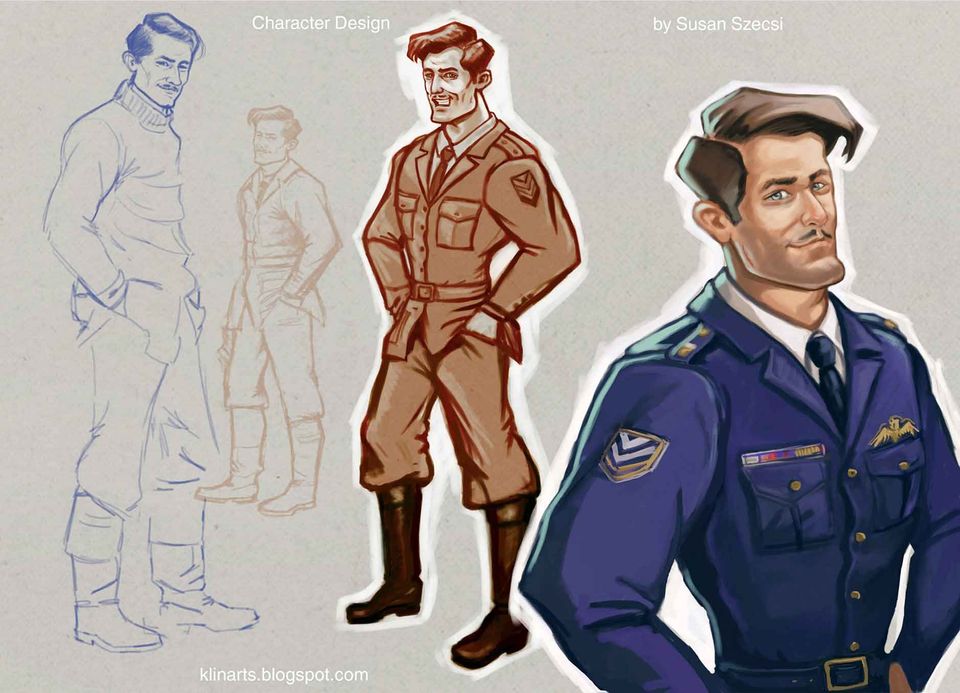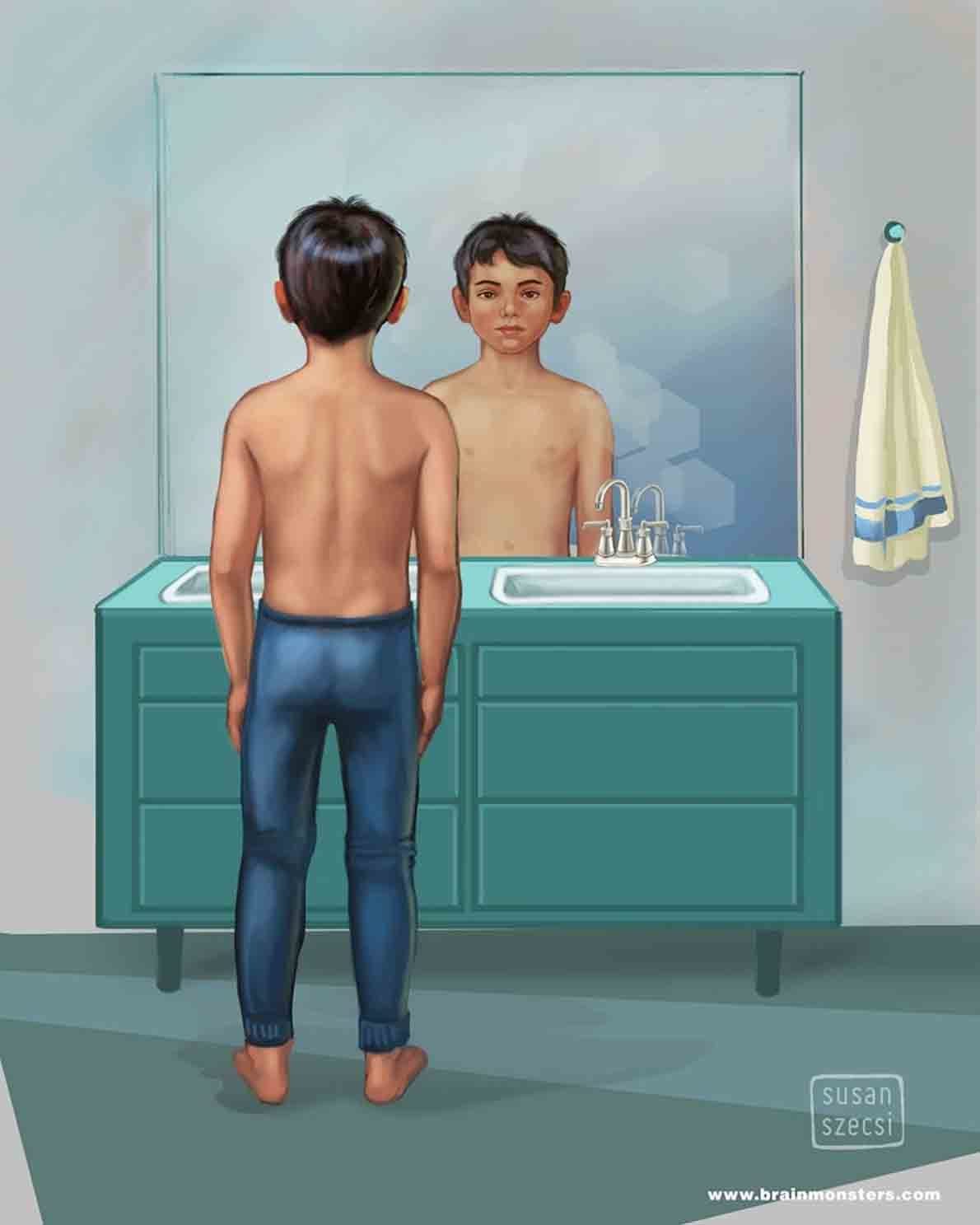Scriba Spotlight: Susan Szecsi
February 25, 2020
Everyone’s work is deeply idiosyncratic: in our regular Spotlight segment we explore artists’ experiences and inspiration to understand what defines and inspires their unique styles.
Susan Szecsi is a designer who designs human like fantasy game characters. In this article Susan will go through the step by step process she uses when she is designing these characters.

Step 1. How to start and what to look at the references
I almost always start the job with researching and collecting references. Looking at them helps to feel the atmosphere of the era and you will see clearly the hairstyle and clothing or other props that can add to the character. In this case the blue line drawing on the left is the first sketch based on a real British fighter's vintage photo. He is wearing a pullover with a unbuttoned jumpsuit. His carefully trimmed mustache is very stylish. I made his face more characteristic, slightly based on another contemporary pilot's features. Although I liked his natural and confident look he was not what I was looking for. I was drawing him because I thought his study would help me to create the fictional pilot for the game. To get that look some exaggerations were needed.
Step 2. Exaggerating, checking, refining and... sometimes let it go
Admitting (after a satisfying first sketch or study) that your second approach is a failure is not easy. The smallest light brown sketch (only lines, no blocking) shows an abandoned version where I was going in the wrong direction. I drew it over the first sketch, but now our hero is wearing a uniform. Unfortunately, his posture is not specific enough, his facial features are way too general, and his body type is average. It is a good example for a bad design. He is so uninteresting and somehow rigid the best we can do is just let it go and start all over. It is always good to make thumbnails with loose, sleekly, straight, and curvy lines. Draw the spine, a kind of simplified skeleton of the guy, to get the character anatomically correct. I use my other references, sometimes 2 to 6 photos to get the right posture. Family members or friends have to pose when there is no other way to get it right. There is no detailed rendering that can fix a wrong or uninteresting posture.
Step 3. How to refine or modify your character
Since the aim was to provide not an artistic or lifelike, but rather a game-fitting guy I started to play with the proportions. By simplifying the lines I was looking to find, while keeping his posture in mind, it should suggest confidence with a hint of an easygoing attitude but somewhat arrogant as well. He knows he is good looking and after dozens of fights shooting others and almost being killed, he sees the world with different eyes. He does not give a damn about what Mr X thinks of him. On the other hand, he is not cynical but rather smart and charming with a dry sense of humor. So, I broadened his shoulders and slimmed his waist. Not only did he get an almost sculpted hairstyle, but his jawline got more square like and his chin came forward. I love rendering and get carried away easily by colouring or refining details, so I worked only with values as you see it in the brownish blocked image in the middle.
Step 4. Further refining, checking, and experimenting
It is always a good idea to swap the canvas horizontally, or in the case you are not working digitally, using a mirror. It helps to see your drawing with fresh eyes and mistakes will pop up. Working digitally you have the opportunity to check the values when you look at your design in grey scale. The coloured close up shows more rendering. In fact, I have made 4-6 more versions of the character. However, I did not find them acceptable yet. I am going to continue to simplify him.
Thank you for reading. If you have any questions just drop me a comment. You can see more of my work at klinarts.blogspot.com
Scriba is a revolutionary digital stylus that is ergonomically designed to comfortably fit your hand and uses unique Squeeze-Motion technology. Order here.
Articles

In the period since COVID forced many of us back home and out of the office, remote work has become the new norm for many. The flexibility of working from home, especially for those with small children, is very compelling, but making a productive workspace is more than setting up a desk in the spare room. More people are seeking to create functional and comfortable workspaces in their homes, however, it can be difficult to strike the right balance between a professional office space and a cosy home environment. Here are some tips for designing a home workspace that meets both of these needs: Dedicate a specific area for work Designating a specific area for work is essential for separating work from leisure time. This could be a separate room or just a corner of a room. It is important to make sure that the workspace is free from distractions and clutter, as this will help you stay focused and productive. Choose the right furniture Ergonomic furniture is key to a comfortable and productive workspace. Invest in a comfortable chair, a desk that is the right height, and a good-quality mouse and keyboard. If you are prone to back pain, consider a standing desk. Add personal touches Just because your workspace should be functional, doesn’t mean it can’t be personal. Add photos, plants, and other personal items to make the space feel like your own. This will help create a sense of comfort and make you feel at home in your workspace. Good lighting Good lighting is essential for a comfortable workspace. If possible, place your desk near a window for natural light. If not, invest in a high-quality desk lamp to provide bright, even light. Keep it organised An organised workspace will help you stay productive and focused. Use desk organisers, filing cabinets, and other tools to keep your work area free from clutter. A clean and organised workspace will also help you start each day with a clear mind. Consider your work style Think about the type of work you do and how you like to work. If you prefer a minimalist workspace, opt for a simple desk and a few basic supplies. If you need space for multiple screens and other technology, make sure you have enough room to work comfortably. Take breaks It’s important to take breaks throughout the day to avoid burnout. Step away from your desk, go for a walk, or do some stretching exercises to clear your mind and recharge.











